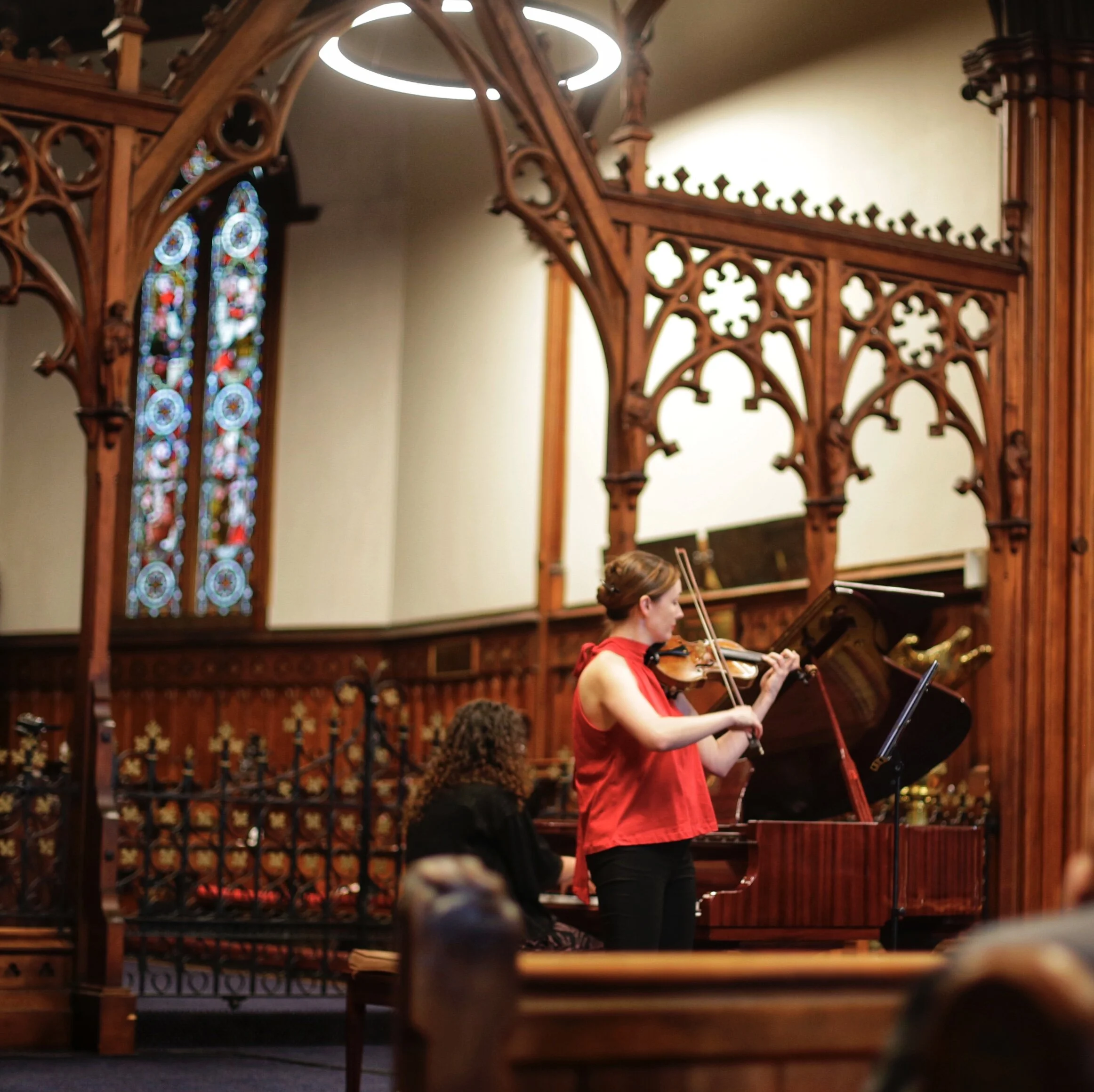Inside, outside and not about gender
SMP Ensemble plays Into the Light by André Nowicki.
The SMP Ensemble’s recent concert at St Peter’s in Wellington, “Inside-Out”, explored musical and other ideas related to the duality of the title. It was typical of the inventive programming of this Ensemble, a grouping of Wellington performers and composers with links to the NZ School of Music at Victoria University. I’m not sure what the letters “SMP” stand for but their themed concerts over the past dozen or so years have always been full of interest, creativity and talent, attracting enthusiastic boutique-sized audiences to explore a wide range of mostly contemporary music.
“Inside-Out” began and ended with compositions by SMP’s founder, André Nowicki. He described his uncomfortable Insularity for string quartet and piano as “reflections on lockdown, isolation and a world in crisis”. The piece is hyper-expressive, beginning with descending glissandi on harmonics for the string players and moving on to explore other string and pianistic effects.
Interference by Simon Eastwood had two pianists sharing one grand piano, a visual representation of “inside-out” with Gabriela Glapska at the keyboard and Liam Furey playing inside the instrument. "A musical discourse is created,” says the composer “by the way the two parts interfere with each other.” In fact this highly successful composition mixes interference and cooperation, both beautifully managed by the performers. The shifting “preparations” of the piano strings under Furey’s hands created a sophisticated multi-coloured sound world of alternating percussive effects and ringing pitched tones.
Gillian Whitehead’s Arapatiki - “an ever-varying waterscape”
Gillian Whitehead’s Arapatiki is one of a set of solo Landscape Preludes commissioned by pianist Stephen de Pledge from several composers and first performed at Wigmore Hall in 2004. The name refers to the sandflats in front of the composer’s house on the outskirts of Dunedin, which Whitehead has described as “an ever-varying waterscape with the advance and retreat of the tide and the sea and water birds.” The opening uses the fluting song of the korimako (bellbird). It’s a work that depends on the translucent beauties of piano sound; Furey achieved this in the final gestures but for much of the performance the apparent limitations of the venue piano denied us the full dynamic and timbral range of this lovely piece.
Uchi-Soto by Salina Fisher is also for piano solo. The title (literally “inside-outside”) refers to the subtle distinctions in Japanese society in relationships and behaviours between ‘in-groups’ such as family and close friends and ‘out-groups’, which may include strangers and foreigners. As always, Fisher offers a beautifully constructed work with a clear logic. Uchi-Soto uses the inside and outside of the piano with carefully placed gestures and Furey here found the luminous sounds required by this wide-ranging composition.
Monique Lapins (violin) and Gabriela Glapska (piano)
…lovely rapport in music by Lili Boulanger
Violinist Monique Lapins joined Glapska to toss off two challenging little pieces - Deux Morceaux - by Frenchwoman Lili Boulanger, who died in 1918 aged just 24. Lapins revelled in Boulanger’s deliciously French style with light, flexible playing and a consistently lovely rapport with Glapska. The audience responded enthusiastically to their dynamic approach in Cortege, the second Morceau, which ends with a splendid flourish.
The programme came full circle with the largest ensemble of the night in another piece by Nowicki for string quartet and piano, this time with the addition of Genevieve Davidson on soprano sax. Into the Light is the composer’s “response” to his Insularity and is a more optimistic work with glowing light-filled textures and harmonies. Davidson’s whimsical, improvisatory saxophone engages the other five players in musical conversation before repetitive figures pick up the pace and tumble to a dramatic and surprising ending.
A postscript: The SMP Ensemble’s “Inside-Out” concert took place two days before International Women’s Day 2021. There was no mention of gender, which was indeed irrelevant to the programming concept, but I was in part attracted to the concert because three of the five composers featured were women.
Three remarkable women composers in one programme! - one not even billed as a special programme of “women’s music”. In New Zealand only the contemporary music ensemble Stroma under the enlightened leadership of Michael Norris and Hamish McKeich has been so bold. Stroma’s explicit policy of 50-50 gender representation in current programmes appears to be no audience deterrent. Some of us, in fact, are positively attracted by such programming.
“Music by women”, of course, is not a homogeneous category, style or genre, any more than is “music by men”. But women composers have been “outside” the programming tent for too long. I’m raising equitable representation of women’s music in programmes because progress on this issue by some of our bigger concert-giving institutions is happening at a glacial pace. High quality repertoire by women is available from all periods of music history. Perhaps adventurous groups like SMP Ensemble and Stroma are showing others the way?
SMP Ensemble “Inside-Out”, in Wellington on 6 March, 2021. Music by André Nowicki, Simon Eastwood, Gillian Whitehead, Salina Fisher and Lil Boulanger, performed by Salina Fisher and Monique Lapins (violins), Elliot Vaughan (viola), Charley Davenport (cello), Genevieve Davidson (soprano sax), Gabriela Glapska and Liam Furey (piano).



